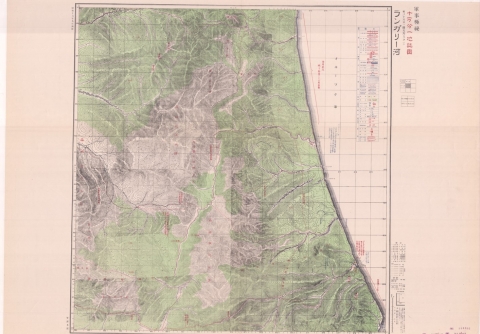Table of Contents
Overview
Access the entire cataloged collection here in Searchworks. The collection holds over 120 different sets, which will be released through the index viewer as the indexes are created.
 |
Sinyang, South Pyong An Province of North Korea 1:50,000 First surveyed in 1917, updated in 1932, reprinted in 1947. |
Stanford University Libraries holds a large collection of Japanese military and imperial maps, referred to as gaihōzu, or "maps of outer lands." These maps were produced starting in the early Meiji (1868-1912) era and the end of World War II by the Land Survey Department of the General Staff Headquarters, the former Japanese Army. The first charge was to map specific territories beyond Japan's borders. Over time the mapping efforts grew to including "mapping of interimperial boundaries, cadastral surveys of the colonies, and detailed drawings of strategic cities and fortifications." Geographically the Stanford maps cover a broad area including Japan, China, Mongolia, North Korea, South Korea, the Philippines, and beyond.
The Library is in the process of scanning and making available all of the maps in the collection. In order to quickly assess what we hold for each region, we have created an ArcGIS online interface to access each set. This portal allows you to search for the maps geographically through an index and then download the images at multiple resolutions. This guide provides access to the indexes, details the history of how the maps came to Stanford, and provides resources for further information about this corpus of material.
Distribution of the Maps
Maps were distributed to libraries in the United States through the Army Map Service and the Library of Congress's Map Depository Program. Maps also came to Stanford directly from the Hoover Institute Tokyo Office in 1947 as part of the Wright Project. Dr. Shigeru Kobayashi has written a detailed text in Japanese about these maps entitled, "Gaihōzu: Teikoku Nihon no Ajia chizu." Dr. Kobayashi paper presented at the Stanford Symposium gives a detailed history of the maps in English entitled, "Japanese Mapping of Asia-Pacific Areas, 1873-1945: An Overview."
A listing of known libraries that hold Japanese military and colonial maps produced up to the end of World War II.
| Academia Sinica, Taiwan | Southern Methodist University |
| California Academy of Sciences | Stanford University |
| Carleton College | Tohoku University, Japan |
| Claremont College | University of Arkansas |
| Clark University | University of California, Berkeley |
| Cleveland Public Library | University of Chicago |
| Gifu Prefectural Library, Japan | University of Colorado |
| Harvard University | University of Georgia |
| Kyoto University, Japan | University of Hawaii, Manoa |
| Library of Congress | University of Illinois |
| Louisiana State University | University of Iowa |
| National Geographic Society | University of Michigan |
| National Library of Australia | University of New Mexico |
| New York Public Library | University of Oklahoma |
| Northwestern University | University of Pittsburgh |
| Oberlin College | University of Tennessee |
| Ochanomizu University, Japan | University of Texas |
| Oklahoma State Library | University of Washington |
| Oregon State University | University of Wisconsin-Madison, American Geographical Society Library |
| Osaka University, Japan | Washington State University |
| Princeton University |
Yale University |
| San Diego Public Library |
|
Resources
 |
East Russia and the Sea of Okhotsk Legend includes ground surface by seasons, transportation conditions for soldiers and pack animals |
Numerous resources have been created in both print and electronic form to aid researchers in the use of the maps. Many of them are in Japanese. Below you'll find books, web resources, and conference proceedings related to the collection.



 Stanford University Home
Stanford University Home